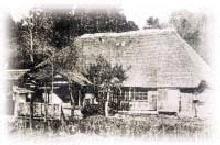Ninomiya Sontoku

Statue of Ninomiya Sontoku at Ishigami 2nd Elementary School
If you visit one of the elementary schools in town, you may spot a statue of a boy reading a book while carrying a bundle of firewood on his back. In fact, you can find him in or in front of schools all throughout the country. This boy is Ninomiya Sontoku, an agricultural leader, economist, and philosopher whose teachings helped shape economic development in 19th-century Japan.
Life

Photo of Ninomiya's home.
Ninomiya was born in the latter half of the Edo period in 1787 in the Ashigarakami District of Sagami Province (part of current-day Kayama, Odawara City in Kanagawa Prefecture). Born with the name Kinjiro, he was the eldest son of a relatively wealthy family of farmers who owned 2 hectares of land (0.02 square kilometers).
In the summer of 1791, fierce wind and rain caused the Sakawa River running through the village to overflow, burying the Ninomiya fields in earth and sand and casting the family into poverty. Kinjiro’s father became extremely sick in 1797, and so 11-year-old Kinjiro had to take his father’s place in building embankments.
Two years later, his father passed away, leaving Kinjiro to become the sole caretaker for his mother and two younger brothers. In order to provide for them, he would get up early in the morning to gather grass from the mountains and spend all day working the fields. At night, he would weave the grass to create items such as waraji, or straw sandals. To add to his misfortune, however, Kinjiro’s mother passed away two years after his father, and in June of the same year the river flooded again, desolating the farmland once more.
Kinjiro’s two younger brothers went to live with their mother’s family, while Kinjiro was sent to his uncle’s house. There, he decided that the only way to improve his lot in life was through study. He would often stay up reading until late into the night.
At the age of 18, Kinjiro returned to his childhood home. He repaired the desolated house and cultivated the abandoned land, buying back his father’s plot little by little. By the time he turned 23, he owned 1.5 hectares of land and had successfully restored his home.

Drawing of Ninomiya Sontoku
In 1808, a retainer from the Odawara Domain (another part of Sagami Province) visited Kinjiro and requested his aid in rebuilding his household’s economy. He was able to do so largely through agricultural development, becoming well-known throughout the domain. Eventually he was recruited to help run the Odawara Domain, and later the entire Sagami Province. In 1842 he became a samurai at the age of 55 and reported to the shogunate under the name Sontoku.

Statue of Ninomiya Sontoku at Ota Elementary School
An important part of Sontoku’s success and teachings was his study of economics. He emphasized the importance of compound interest and saving surpluses for land development or lean years. He also provided monetary incentives for migrants who successfully set up agricultural households and established his own financial institutions called 五常講 (gojoukou), through which he lent money out to farming communities to help them recover and grow. The combined use of these techniques were highly successful and spread across the country.
Sontoku’s health began to wane in 1853 due to illness, and he passed away in 1856 at the age of 69. However, his legacy has had lasting impacts on the agricultural and economic landscape of Japan.
Philosophy
Sontoku’s philosophy centered around the idea of “報徳 (houtoku)”, or repaying the kindness received from humanity’s labors and heaven and earth’s upbringing of all things. He argued that not only should we live in a spirit of thankfulness, but we should also act upon that thankfulness. He summarized this idea with four main principles:
- 至誠 (shisei), or sincerity – this is the center upon which all of Sontoku’s other teachings were based. He saw an honest and compassionate heart as incredibly valuable.
- 勤労 (kinrou), or diligent labor – Sontoku believed that with hard work one could obtain everything one needs to live, while those who did no work would not even be able to procure a meal for themselves. Through hard work, a person could improve themselves.
- 分度 (bundo), or living within one’s means – it is important to take into account one’s situation and standing, and choose a lifestyle that best fits those parameters.
- 推譲 (suijou), or conceding one’s position – this involves thinking about the future through both saving money for one’s family and descendants as well as working for the benefit of others and society as a whole.
Sontoku also created a couple four-character idioms known as 四字熟語 (yoji jukugo). One such idiom described how everything in the universe combines and works together to create singular results. For instance, plants were the culmination of water, temperature, earth, nutrients, and sunlight. If even one part were missing, the plants would not grow. He put this into words through the saying 一円融合 (ichien yuugou): all things are tied together in a single circle.
Another saying stemmed from Sontoku’s time studying late into the night. In order to get fuel for his lamp, he would gather saplings from abandoned land and use them make oil. He would also gather saplings that had been thrown away and grow them on the plot of land he had managed to cultivate, yielding a bale of rice in the fall, which he could also trade for oil. These experiences at a young age taught him the lesson of 積小為大 (sekishou idai): small efforts pile up to achieve big things.
Sontoku used teachings like these to instill a sense of pride and dignity in farming areas as they worked to improve their community. He worked hard to spread his teachings until his death in 1856.
Legacy in Minamisoma

Statue of Tomita Koukei
Many of Sontoku’s followers worked tirelessly in the Soma area to implement his teachings and improve the economic situation of the area. At the heart of these efforts were Tomita Koukei, Saitou Takayuki, and Ara Muneshige.
During those days, the Soma area was known as Nakamura Province and was ruled over by the Soma clan. The area suffered multiple poor harvests, causing many farming communities to fall into ruin. Several policies were put into place in an effort to counteract the economic deadlock, but to no avail.
In the middle of these difficulties, a Soma Nakamura warrior’s son named Tomita Koukei headed to Edo in 1814 to study and find a way to help his hometown. He heard of Sontoku’s teachings and began training under him in 1839, becoming one of his top followers. He even married Sontoku’s daughter and became an official part of the family. After Sontoku’s death, Koukei began publishing his teachings in order to spread them even further. At the beginning of the Meiji period in 1868, Koukei took his family and fled back north along with Sontoku’s son Sonkou and his family to avoid the Boshin War, eventually building a home in Ishigami Village (now Ishigami, Haramachi) next to Sonkou family. Koukei continued to care for the Ninomiya family and spread Sontoku’s teachings until his death in 1890.
Koukei’s nephew, Saitou Takayuki, also became a follower of Sontoku’s teachings, working alongside his uncle to implement them in the Nakamura Province. He also continued his uncle’s work of gathering and publishing sayings by Sontoku and the lessons of houtoku.

Photo of Ara Muneshige
Another of Sontoku’s followers, Ara Muneshige, moved from Nakamura Province to Edo to study arithmetic and surveying. There, he became a disciple. Armed with Sontoku’s teachings in combination with his previous studies, he built many irrigation channels and reservoirs, such as the Kaibama irrigation channel in Haramachi.
These three men, along with other disciples, pushed to make Sontoku’s teachings a reality in Nakamura Province. Starting in 1845 with the two villages of Tsubota and Narita (combined into current-day Soma City), Sontoku’s teachings were implemented in one village after another. After 19 years, a little over half of the villages in the area had implemented the changes, and roughly half of those were successful in recovering and reshaping their community.
Sontoku’s life had long-lasting effects on the area, and is widely revered here as a result. His fingerprints can be seen throughout Minamisoma in the statues, reservoirs, stone monuments, and shrines bearing his name. East of the Ninomiya former residence site (now the site of the Ishigami Lifelong Learning Center), you can find a grave with his name on it. It was built in 1955 in a 100-year commemoration ceremony, and is based on the actual gravesite at Houtoku Ninomiya Shrine in Tochigi. In the same plot in Ishigami are the graves of Sontoku’s wife, their son and his wife, and their grandson’s wife, along with the grave of Tomita Koukei. They are regularly cleaned by the Ishigami Lifelong Learning Center Ishigami Houtoku Lecture Students, who continue to study his teachings.
- この記事に関するお問い合わせ先
- このページに関するアンケート
-
より良いウェブサイトにするために、このページのご感想をお聞かせください。















更新日:2021年02月12日